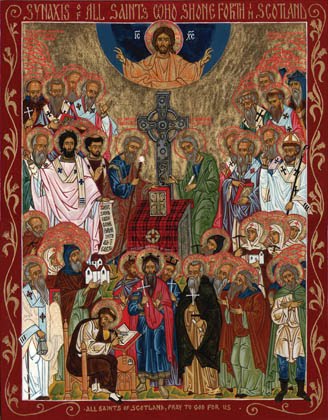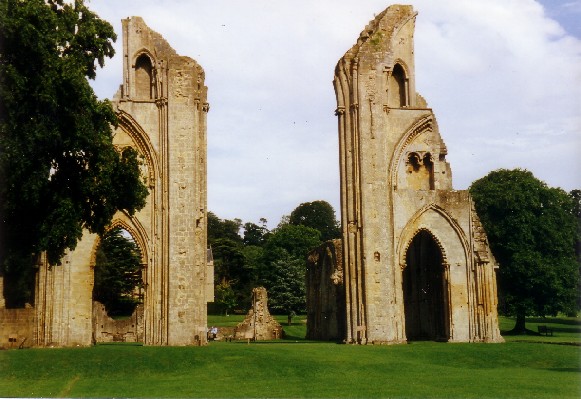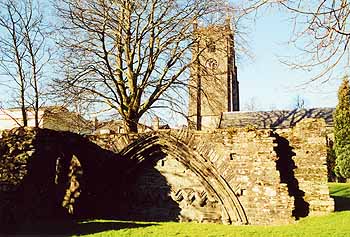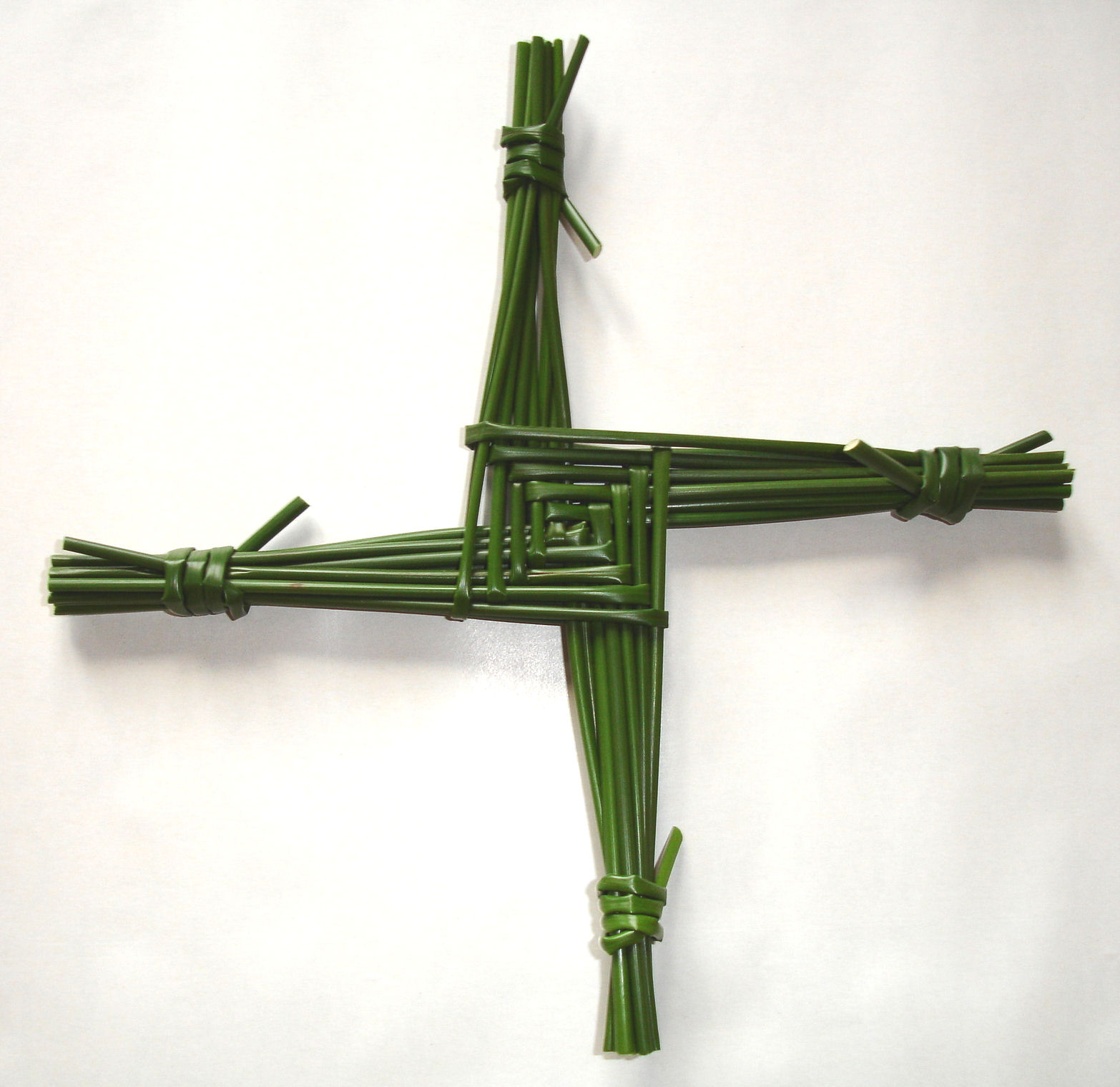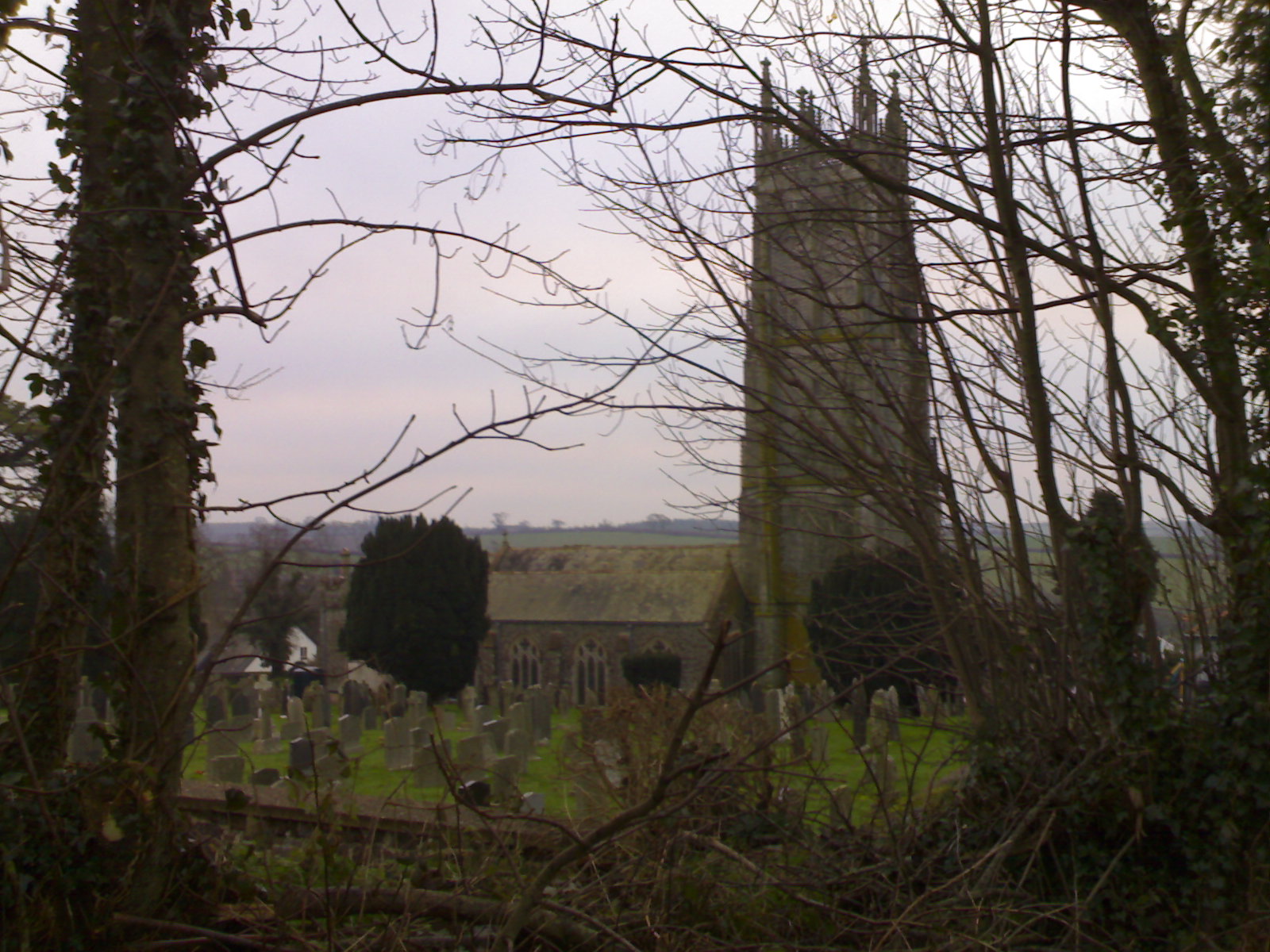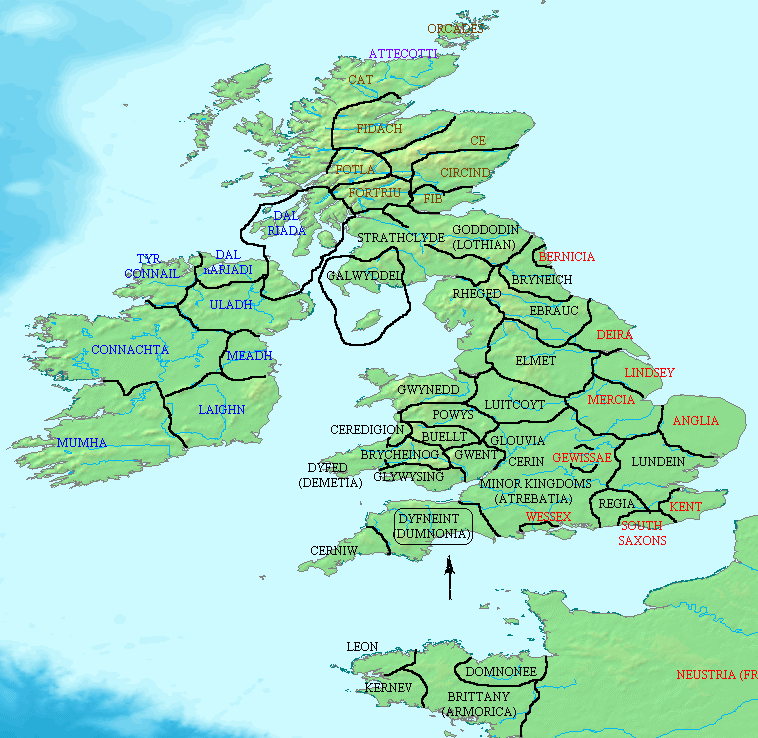The original icon (above) of Our Lady of Glastonbury hangs in the Chapel of Saint Simeon & Saint Anna, Combe Martin. It was painted by Fr David (of blessed memory) founder of the Orthodox Brotherhood of Saint Seraphim at Walsingham. It depicts the Mother of God and Her Son. Christ holds the universe and the Holy Thorn. Also represented are the Archangel Michael, Saint Aristobulos, Saint Joseph of Arimathaea, Saint Patrick, Saint Brigid, Saint Beon, Saint Indracht, Saint Fili, Saint Kea, Saint Ruman, Saint Domenica, Saint Collen, Saint Gildas and Saint David, all of whom traditionally have associations with Glastonbury.Ruins of Glastonbury Abbey (early 6th century A.D.)Saint Rumon - 5th JanuaryAccording to Glastonbury's list of relics Rumon was a son of the King of Brittany. He was born in the early sixth century and probably studied the Scriptures in Ireland, returning to Britain with St Breaca.Although he is the patron saint of Tavistock and was a companion of Sts Fili and Kea and features with them on our Glastonbury icon, the stories of his life have him in Brittany. There he built a hermitage and local peasants and grandees alike sought his advice. When he died his body was originally buried in Brittany. According to Sabine Baring-Gould his relics were brought to Britain for safety during the Viking raids in the early tenth century. In 960 they were brought to the newly founded Tavistock Abbey and there they worked miracles until the monastery was dissolved by Henry VIII.Tavistock Abbey (founded in 960 AD - plundered and burnt by the Danes in 997 AD)Saint Gildas - 29th JanuarySt Gildas came from the Clyde area, son of the northern King Caw. He was educated in the south then returned home to do missionary work, which later took him to Wales. Not only was he a monk but also a historian - mostly remembered for his work 'De Excidio Britannae'.Some stories associate Gildas and his family with King Arthur, with whom there was a long-standing feud, which was finally settled with the help of St Cadog.St Gildas lived much of his life as a hermit, for a while on the island of Flatholm in the Bristol Channel and finally in Street, then known as Llantokey, where he died on 29th January 570 and was buried in Glastonbury Abbey.Saint Brigid - 1st FebruarySt Brigid was born in Ireland in 452 to a Christian mother who was a slave of her father, the pagan chieftain of Leinster. Brigid suffered hardships as a child but she remained cheerful and was kind both to people and to animals.Like her mother she worked for her father in the kitchen and dairy and gave away food to the poor. When her father protested she replied, "Christ dwelt in every creature". He tried unsuccessfully to sell her to the King of Leinster and eventually gave her freedom.Brigid refused good offers of marriage and instead founded the first women's monastery in Ireland at Kildare, so called because it was under a giant oak tree and was known as the 'church of the oak', or Cill Dara. This monastery became a centre of religion and learning. Brigid also founded a school of art, which became famous for illuminated manuscripts, as well as continuing to help the poor and the sick.Whilst comforting a dying pagan with stories of Christ, she unwittingly wove a cross from the rushes that covered the floor. This simple rush cross known as St Brigid's Cross is still made in Ireland and placed in the rafters of houses on her feast day.According to the Book of Lismore, St Brigid was 'abstinent, she was innocent, she was prayerful, she was patient; she was glad in God's commandments; she was firm, she was loving; she was a consecrated casket for keeping Christ's Body and His Blood; she was a temple of God, her heart and mind were a throne of rest for the Holy Spirit.'Brigid died on 1st February 525 in Kildare. Bridestowe parish church, near Okehampton is dedicated to St Brigid.Saint Ia - 3rd FebruarySt Ia was born in Ireland in the fifth century and later came to Cornwall. She should have come with St Fingar and his companions but they set off without her. Obviously her mission to Cornwall was pleasing to God because miraculously a large leaf appeared to take St Ia on her journey, and although she left after St Fingar's party she arrived before them. She spent many years doing Christ's work before she was martyred along with other missionaries.Saint Piran - 5th MarchSt Piran is another fifth century saint of Irish heritage. He spent his youth in South Wales where he became friends with St Finnian and the two men returned to Ireland together.As an old man in Ireland, St Piran was captured by local pagans who were jealous of his power to heal. They put a millstone round his neck and threw him off the cliffs into a raging sea. As soon as he hit the water the seas calmed and the millstone became like a cork, which he used as a raft and set sail for Cornwall. He landed at Perran Beath and built an oratory at St Piran-in-the-Sand.According to Geoffrey of Monmouth St Piran became chaplain to King Arthur at Tintagel.St Piran became popular in Cornwall because he provided the people with a profitable living. Having made a fireplace from a large lump of black rock, he noted that as the flames grew hot a trickle of pure white metal (tin)oozed from it. This white trickle on a black rock is symbolized in the Cornish flag: a white cross on a black background.Saint Petroc - 4th JuneSt Petroc was the son of a Welsh king, but he refused to succeed his father. Instead he and his retainers became monks. He spent some time in Ireland before going to Cornwall. He landed in the Camel estuary with a group of companions (Sts Croidan, Medan and Degan whose memories we also keep today) and travelled to Padstow. On the way he met some men working in the fields and asked them what their religion was. Not being a couth bunch and wanting to test Petroc's holiness they said they were thirsty and asked if he could make a rock produce water. Petroc hit the rock with his stick and out came pure fresh water, and this spring has never dried up.Petroc lived in Cornwall for thirty years, founding a monastery in Bodmin where he observed a strict and severe rule - spending nights in cold rivers and eating a very meagre diet of bread and on Sundays, because it is the day of the Resurrection, a few pulses. He was a great lover of animals and his saving a stag from huntsmen led to King Constantine of Cornwall being converted to Christianity, and later dying as a martyr.St Petroc was also a great traveller. He went on a pilgrimage to Rome and then to Jerusalem. From there he set out for the East, to India and beyond before returning to Cornwall seven years later.On 4th June 564 Petroc succumbed to the rigours of his ascetic life and constant missionary work and his body was interred at Bodmin. But Petroc's travels didn't stop there. After the feast of the Epiphany in 1177 a Breton priest stole the body and took it back to Brittany as a gift for the Abbey of St Meen. The prior of Bodmin appealed to Henry II who ruled Brittany at that time and the monks of St Meen relinquished the relics and they were returned to Bodmin in an ivory casket, which itself was stolen only a few years ago.Saint Nectan -17th JuneSt Nectan was born in 468, the eldest son of a Welsh king, and had twenty-four brothers and twenty-four sisters. He was inspired by the life of St Anthony of Egypt and became a hermit. He left Wales intending to live wherever his boat landed, which was at Hartland Point. At nearby Stoke he built a church and a hermitage and lived a solitary life, except for his brothers' and sisters' annual visit after Christmas.In 510 Nectan was given two cows by a swineherd for helping find his lost pigs. On 17th June that year two robbers stole the cattle, but Nectan tracked them down and tried to convert them. In their turn the thieves cut off Nectan's head. Nectan picked up his head and went home. It is said the dark pink foxgloves that line the verges in June grow where drops of his blood fell. Back in Stoke he laid his head upon a rock by a well and died.Saint Brannoc - 26th June (in Braunton & North Devon, 7th January elsewhere)St Brannoc lived in the sixth century and was tutor to the children of King Brychan of Wales. He left Wales for several years, first travelling as a pilgrim with the king to the Tomb of the Apostles, then spending some years in Brittany where he founded many churches.He is said to have come to North Devon floating on a stone coffin and first settled in a cave in Mortehoe. He built his first church in the area where St Brannoc's Well is now, but it fell down. In a vision he was told to build a church where he found a sow and five piglets, and he found them in the village of Braunton. Having settled in Braunton he spent his life teaching holiness and husbandry.Saint Urith - 8th JulySt Urith lived in the 7th century. She was born in East Stowford, near Barnstaple and converted to Christianity by St Kea. She lived as a hermit in nearby Chittlehampton, where she founded a church. At the behest of a jealous, and pagan, stepmother some female haymakers killed Urith with a scythe. The moment she fell to the ground and died a spring appeared at that place. She was buried in the church she founded.From that moment her shrine became a popular place of pilgrimage - Chittlehampton church owes its tower to the pilgrims' donations. As with so many of the country's other sacred sites, her shrine was removed during the Reformation and veneration of her relics forbidden.Chittlehampton Church - near DevonSaint Sidwell - 2nd AugustIn the county of Devon, in a city called Exeter after the river that flows through it, there lived a man of noble birth and virtue by the name of Beorna. He had one son and four daughters - one of whom was recognised to be of great goodwill in the Lord; her name was Sidwell. Nature and grace so worked together in her that they conferred on her a title of praise for beauty of form and moral integrity. But since the good are often persecuted by the jealous, and traps are sometimes laid for those having good fortune, after the funeral of her mother she was soon falsely ensnared by a stepmother's hostility.Thus, Sidwell was persuaded by a stepmother consumed with greed to go out through the city streets and beyond into the fields of which this schemer planned to rob her, harbouring in her breast a wicked plot to murder the holy girl. And so one day the serfs mowing meadows outside the city walls were induced by her to undertake a deadly attack on the virgin the following day, when she would come by herself to bring them food. Seduced by the hope of reward, the serfs agreed, promising to carry out the woman's instructions.Next day the virgin, holy and guiltless, carrying down the food by herself to the meadows that were being mown, was sent by her stepmother to execution. As the virgin came near, these most wicked serfs drove their scythes through the neck of the innocent one. While approaching however, she had forebodings of her death; she calmly handed them their food and fortified herself with prayer. Her head cut off, she rendered back her spirit to her Creator.Now the Divine Mercy, which distributes gifts of different kinds, not hesitating to make manifest the purity of virginal innocence caused the clearest of springs to well up in the place where the virgin's blood spattered. Seeing this, the butchers wanted to conceal the villainy they had perpetrated; and although unable to cover the spring with grass, they tried to hide the body. But lest through their silence she should be robbed of her title to sanctity, the city watchmen on their nightly rounds saw a brilliant shaft of light from out of heaven shining over the virgin's body. This they saw for three nights; and on the fourth night following, to their dread, they saw the body of the virgin herself, surrounded by a radiance, carrying her severed head in her hands, from the place of her martyrdom to the place where the faithful Christian community subsequently built the virgin's church. Here in the morning, prompted by the heaven-sent sign, the people came in haste and found the virgin's head, not rolled elsewhere but joined to the body, just as if it had been placed there by the care of the faithful. So she was buried in that very place, Christ's martyr Sidwell, by whose merit into our own times, the lame walk, the blind see, and a multitude sick with various diseases find healing and perfect health.(From Legenda Sanctorum by Bishop John Grandisson of Exeter 14th Century)St Winifred - NovemberSt Winifred, St Gwenfrewy in Welsh, was the daughter of a rich Welsh Lord. Wishing to escape the attentions of some young princes, she moved away with her uncle, St Beuno, to Abeluyc.One day when Winifred was left alone in the house whilst everyone else had gone to church, King Caradog stopped at the house. He was very taken with Winifred's beauty, but she was not taken with his advances and rejected him, whereupon he tried to use force. Winifred fled to towards the church and the furious Caradog chased her. On the steps of the church Caradog cut off her head. Immediately, a spring of pure, clear water appeared where her head fell.St Beuno rushed from the church and taking her head he set it back in its place. Then he and the congregation prayed that she would be restored to life. Their prayers were answered.In thanksgiving, Winifred decided to devote her life to Christ, first staying in the church at Abeluyc with eleven maidens to whom she gave religious instruction.After a pilgrimage to Rome she called the holy men and women of Wales to the 'Synod of Winifred', where it was agreed that living a religious life in a group was preferable to the life of a hermit. Creating new establishments similar to the one at Abeluyc was not easy for Winifred as not all the hermits were interested in these new-fangled ideas. Eventually she met St Tenoi, mother of St Eleri, and they set up a monastery in the village of Gwtherin. Winifred eventually became its abbess and when she died on 3rd November 660 she was buried in the cemetery there. In 1136 her relics were moved to Shrewsbury Abbey where a splendid shrine was created.St Winifred is not a Devon or Cornish saint, but Manaton church is dedicated to her and Culbone church also has a connection with the saint.This tiny church (35 foot long) is situated in a steep wooded valley near Porlock and can only be reached by foot.The name Culbone is thought to come from 'Kil Beun' meaning Church of St Beuno, St Winifred's uncle, born in 550. He died in 642 and his feast day is 21st April.Saint Kea - 5th NovemberSt Kea was possibly of Cornish descent and came as monk from Glastonbury to preach to our part of the West Country and would have been a companion of Sts Fili and Rumon.Kea must have spent some time in Ireland as one story says he came to Cornwall from Ireland floating on a stone. He had been so upset when he was left behind by fellow monks that as he prayed he fainted. When he came round the hollow stone he had been kneeling on was afloat. After many days drifting through storms he arrived at Churchtown Creek on the River Fal.*******************************************************************************Location of Dumnonia - 6th century BritainSource: http://www.orthodoxdevon.org/files/EARLY_SAINTS_OF_THE_ANCIE.pdf
Thursday 29 March 2012
EARLY SAINTS OF THE ANCIENT KINGDOM OF DUMNONIA
Tuesday 13 March 2012
Saint Edith of Wilton (England)
Editha or Ediva, the Latin forms of her name) was an English nun, a daughter of the 10th century King Edgar of England, born at Kemsing, Kent, in 961. Following her death in 984, she became the patron saint of her community at Wilton Abbey and churches were dedicated to her in Wiltshire and in other parts of England. Her life was written by Goscelin, and her feast day is on 16 September.
Life
Edith was the illegitimate daughter of King Edgar the Peaceful, by Wilfrida, or Wulfthryth, a woman of noble birth whom Edgar carried off forcibly from the nunnery at Wilton Abbey. He took her to his manor house at Kemsing, near Sevenoaks, where Edith was born. Under St Dunstan's direction, Edgar did penance for this crime by not wearing his crown for seven years. As soon as Wulfthryth could escape from Edgar, she returned to Wilton, taking Edith with her.
Edith was educated by the nuns of Wilton Abbey, where her mother had become abbess. Standing not far from a royal residence at Wilton, as part of its devotional work the abbey functioned as the contemporary equivalent of a boarding school for young ladies. She took the veil very early, with her father's consent. He offered to make her, while still a child, abbess of three different communities, but she chose to remain with her mother at Wilton. Her father died in 975.
In the year 979, Edith dreamt that she lost her right eye and believed the dream was sent to warn her of the death of her half-brother King Edward the Martyr , who in fact was murdered at that very time while visiting his stepmother, Queen Ælfthryth, at Corfe Castle, in Dorset.
In some reports, Edith was offered the crown of England by noblemen who had supported her murdered brother Edward against her young half-brother, Ethelred, but she refused it. Despite her refusal of honours and power, she always dressed magnificently, and was reported by William of Malmesbury to wear luxurious golden garments.When rebuked by Æthelwold of Winchester, she answered that the judgment of God, which alone penetrated through the outward appearance, was alone true and infallible, adding -
For pride may exist under the garb of wretchedness; and a mind may be as pure under these vestments as under your tattered furs.
She built a church at Wilton and dedicated it to Saint Denis. Saint Dunstan was invited to the dedication and wept much during mass. Being asked the reason, he said it was because Edith would die in three weeks. This proved to be correct when she died on 15 September 984 and suggests that Edith was suffering from a fatal illness.She was buried at Wilton in the new church of St Denis.
Sainthood
Edith was greatly celebrated for her learning, her beauty, and her sanctity,and minor miracles were reported shortly after her death.A week after she died, Edith appeared in glory to her mother and told her the Devil had tried to accuse her, but she had broken his head.Goscelin reports that thirteen years later she appeared in visions to Dunstan and others, to tell them that her body was uncorrupted in the grave. He states that when Dunstan opened her tomb, in the presence of her mother, its "fragrant perfumes gave off the breath of paradise". However, the dating of the event must be doubted, as Dunstan died only four years after Edith. It has been suggested that Goscelin chose to enhance Edith's story by associating Dunstan with her translation.
Following her exhumation and subsequent reburial, Edith's thumb was enshrined separately and became an important relic.
Edith was elevated to sainthood on the initiative of her brother Ethelred, and her cause was also supported by her nephew Edmund Ironside. More surprisingly, Edmund's successor Canute the Great was renowned for his veneration of her. Goscelin reports that on one occasion, while crossing the North Sea from England to Denmark with his fleet, Canute suffered a terrible storm, and fearing for his life he appealed to Edith. The storm calmed, and on his return to England Canute visited Wilton to give thanks for his rescue, "with solemn gifts, and published this great miracle with prolific testimony", subsequently ordering a golden shrine to Edith to be erected at Wilton.
Edith became the focus of a major cult in Wilton and also an important national saint.Goscelin wrote her life, under the title Vita Edithe, in about 1080. The community at Wilton, in looking to her as its heavenly patron, remembered her as a royal lady who had been dedicated to its protection.In his Liber Confortatorius, Goscelin wrote that he often thought of Edith and felt her presence.
Three churches were certainly dedicated to Edith, one at Baverstock near Wilton, another at Bishop Wilton in Yorkshire, and a third at Limpley Stoke in Wiltshire. In the 16th century, after some five hundred years, the third of these churches was rededicated to St Mary, but the other two dedications survive. However, another eighteen churches in England are dedicated to an unspecified St Edith, and it has been suggested that most of these dedications are intended for Edith of Wilton.
Edith's feast day is on 16 September, the day following the anniversary of her death. It has also been reported as 15 September, the anniversary itself.
Seal
The seal of Edith survives. Dated to the period 975–984, it contains a portrait of her, showing her standing with one hand raised and the other holding a book. The inscription identifies her as regalis adelpha, or 'royal sister', taken to be a reference both to her status as a nun and to her being the sister of Edward and of Ethelred. The handle of the matrix has rich acanthus decoration, and the seal is the only one surviving from the Anglo-Saxon period which shows this feature.
Bibliography
- Goscelin, Life of St Edith (of Wilton), ed. Stephanie Hollis, Writing the Wilton Women: Goscelin’s Legend of Edith and Liber Confortatorius (Medieval Women Texts and Contexts 9; Turnhout: Brepols, 2004)
- O. S. B., St Editha of Wilton (Catholic Truth Society, 1903, 6th edition, 24 pp.)
References
- ^ a b c d e f g Kate Pratt, St Edith at bishopwilton.com
- ^ Mrs Jameson, Legends of the monastic orders: as represented in the fine arts p. 95 online at books.google.com
- ^ St Edith of Wilton at catholic.org
- ^ a b Catherine E. Karkov, The ruler portraits of Anglo-Saxon England. Woodbridge, Suffolk: Boydell Press, 2004; p. 114
- ^ Jameson, op. cit., p. 96 online at books.google.com
- ^ a b Sabine Baring Gould, 'S. Edith of Wilton' in his The Lives of the Saints, vol. X [September] (London: John Hodges, 1875), pp. 269-271
- ^ a b c Church of England, The calendar of the Anglican Church illustrated: with brief accounts of the of the Saints who have churches dedicated in their names, or whose images are most frequently met with in England (1851) pp. 226-227 at books.google.com
- ^ Agnes Dunbar, 'Edith of Wilton', in her A Dictionary of Saintly Women (1904)
- ^ Goscelin, Vita Edithe, quoted in Hollis et al., Writing the Wilton Women (2004), p. 40
- ^ Karkov, op. cit., p. 116
- ^ Susan Janet Ridyard, The Royal Saints of Anglo-Saxon England: a study of West Saxon and East Anglian cults. Cambridge: Cambridge University Press, 1988; p. 40
- ^ Ridyard, op. cit., p. 149
- ^ Jane Tibbetts Schulenburg, Forgetful of their sex: female sanctity and society, ca. 500-1100. Chicago: University of Chicago Press, 1998; p. 340
- ^ 'H. N. R.', in William White, ed., Notes and Queries, vol. 44 (1877) p. 127
- ^ William Campbell, Materials for a history of the reign of Henry VII from original documents (1873), pp. 74 & 90
- ^ Francis Goldie, Saints of Wessex and Wiltshire (1885) p. 28
- ^ St Editha of Wilton at books.google.com
Sunday 11 March 2012
The Orthodox Christianity in the British Isles
Bede’s World: Early Christianity in the British Isles
 |
| Durham Cathedral |
RTE: Fr. John, you’ve written a fascinating book on St. Wilfrid and the world he lived in. While Venerable Bede portrays him as an able advocate of the seventh-century universal Church, modern accounts of “Celtic” versus “Roman” Christianity seem far more ready to cast him as a villain. Wouldn’t we be right, though, in saying that Wilfrid, in the eye of the storm, and Bede, our chief observer, are two pivotal figures in any discussion of early Christian Britain?
FR. JOHN: There are so many exceptional figures from the sixth and seventh centuries on these islands that it is difficult to isolate one or two of them. Without Bede, ‘the first scientific genius of the Germanic people,’ as R.W. Southern calls him, we would, of course, know very little about any of them.
His homilies on the Gospels stand beside those of St. Gregory the Great as a monument of patristic writing. He was a monk and a scholar. But his scholarship was the servant of his love for the truth and the Gospel. This is why his writings were of such value to the missionaries from these lands to Germany. And it is why they endure as devotional reading to this day.
St. Wilfrid left no writings. Like Bede, he was a devout monk, whose greatest joy was to pray continuously in his cell, singing the psalms. But his abilities and his times required of him a life of ceaseless activity as a bishop, an abbot, a missionary, and someone at the forefront in dealing with matters of Church order and organization. One physical monument he has left to our day is the crypt at Hexham. It gives us some idea of his great buildings at York and Ripon, which would have inspired generations of Christians. His foundation work as a missionary in Sussex and Frisia inspired his successors and lives on in their continuing Christianity. The great monasteries he founded in central and northern England were centres of the Christian life for generations. His Vita, the first Anglo-Saxon ‘biography,’ remains an inspiration to those modern Orthodox Christians who seek to establish and nurture the faith in our multi-ethnic, multi-faith and often hostile world. But there are so many gigantic figures from these times: Columba, Aidan, Theodore, Finan, Cuthbert….
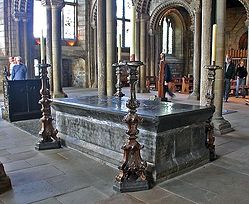 |
| Venerable Bede’s Tomb, Durham Cathedral. |
FR. JOHN: As I understand it, the term “Celtic” was first used in the eighteenth century to refer to language groups. In this linguistic sense, both the inhabitants of Ireland and the inhabitants of Britannia (the “British”) were people whom we now speak of as “Celtic” folk. They were bound together by similarities in language, in which there were two distinct strands: the Gaelic Goedelic branch, and the Brythonic. The Irish and the Scots (who are Irish in origin) use the Gaelic, and the Welsh, Cornish and Bretons (of Brittany in France) use the Brythonic form.
Many people know that it was the Celts of Asia Minor, the Galatians, for whom St. Paul wrote his Epistle. There were also Celts in Galicia in northwest Spain, which had connections with the British Church. There are still many place names referring to Celts in central and western Europe: Gaul itself, Gallia, and the Pays de Galles, the French name for Wales. The name Gall (Celtic) turns up all through Europe – even today the Turkish football team Galatasaray owes its name to the Galatians.
Dates are complicated though, as there were large movements of Celtic peoples before the Romanization of Britain. No one knows when they arrived on these islands, but it was a long time before the Christian period of Venerable Bede and St. Wilfrid. Here in England we had the native British, the Irish (the Scotti) both in Ireland (Hibernia) and in northern Britain, and the Picts further north. The term Scotti came eventually to refer only to the Irish settled in north Britain. When these Scots were eventually united with the Picts, the whole area became known as Scotland.
The Picts may or may not have been Celtic. We don’t know what their language was. About the Picts themselves, very little is known, and nearly every assertion made about them is open to challenge. Their lands were never part of the Roman Empire, and the great walls of Antoninus and Hadrian were built to keep them at bay.
So, when the Romans came here to Northumbria where Bede later lived, the peoples they found were these British peoples. Although the Romans obviously structured the local government around their own cities, they also accommodated these tribal areas and some of the British names were kept by the incoming Anglo-Saxons, such as Bernicia and Deira, the two parts of Northumbria.
Roman Britain
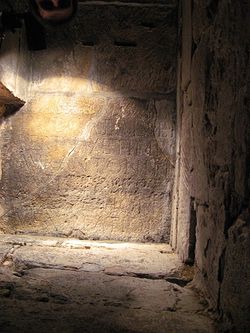 |
| Crypt, Hexham Abbey. |
FR. JOHN: This is a common idea, but it’s not true. From 63 BC to 410 AD the Roman roads were open and well-traveled, and Britain was solidly a part of the Empire. A couple of hundred years ago there was a view that once the Romans withdrew, society fell into shambles and chaos under Pictish invasions. In fact, there’s evidence for marauding Picts, and also marauding Germans. There is good evidence that the British invited the Germanic tribes to help them fight the Picts in the north, and that is one way in which they came. But, there is a lot of debate about this, and some speculation that Germanic peoples came not only as military mercenaries, but also as agricultural settlers, motivated by rising sea levels which forced them to look for new land.
Of course, the Roman troops themselves were multi-ethnic, and many of them would have retired here. They would have been pensioned off with land, and married local British women. Along Hadrian’s wall you have evidence of all the religious life that was current in Rome at that time, quite substantial Mithraic temple remains, as well as Christian elements.
RTE: When the Romans withdrew in 410, did Christianity leave with them, or was there a recognizable tradition left?
FR. JOHN: Not only were things left, but Christianity was well-established.
The Romans had been in Britain about 500 years. We don’t know when Christianity arrived here, but it was certainly aided by the fact that this was part of the Roman Empire, and there is no reason to believe that it was very different from any other part of the Roman Empire, or much further behind in its Church development. We simply don’t have the names of those very early Christians and missionaries; we can’t say that a certain person is the “Apostle to Britain.” Of course, by Orthodox tradition, Aristobulus, one of the seventy disciples of the Lord, is given that title in the Orthodox Menaion, but we don’t have British sources for this, nor does Bede refer to it. It is a Greek Orthodox tradition.
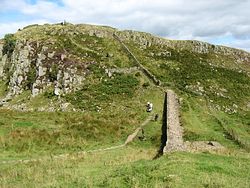 |
| Hadrian's Wall (Steel Rigg) |
FR. JOHN: Yes. Some date St. Alban as early third century, some as mid-third century, some as a victim of the early fourth-century Diocletian persecutions.
A case can be made for each of the three dates, as there was an early Christian persecution in the 220’s, then the 251 Decian persecutions centered in northern Africa, followed by Diocletian’s. The weight of scholarly opinion shifts back and forth over the most likely date of Alban’s martyrdom. Presently, the later date seems to be favoured.
We also have Julian and Aaron, the martyrs of Caerleon, in what is now south Wales, who are mentioned by Bede as being martyred in the same persecution as St. Alban. Some people take the fact of the name Aaron to suggest a Jewish presence here, saying that Christianity may have come through the Jewish communities, as it did in much of the rest of the Roman Empire, but the only evidence for this is the name.
The real archaeological and historical evidence for early Christianity begins in the third century, and there are important fourth-century finds. The archaeological work that has been done in the past fifty years has very much increased our knowledge.
What is certain is that by the time of the Council of Arles in 314 there were three British bishops. We don’t know where these bishops came from, although it is possible that one came from York. We can say, though, that by the early fourth century, shortly after Constantine embraced Christianity, there was probably a full ecclesiastical and diocesan structure here, most probably based on the twelve Roman provinces.
In Ireland things were more complex and unclear. In the fifth century Pope Celestine sent Palladius to be bishop of the Irish. He appears to have been active in the South. At the same time, the Briton, St. Patrick, carried out his work in the North. By the sixth century there was an extensive and vigorous series of monasteries, around which the Church was largely organized. According to Bede, the bishops were under the authority of the abbots, and this has led some to assert that Ireland had no diocesan structure.
There were probably differences across the country, and a full traditional structure came into being only over a long period.
Evidence of Early Christianity in Britain
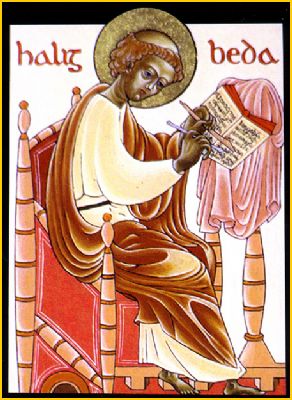 |
| St. Bede |
FR. JOHN: There are some very important things in the British Museum. From Lullingstone, a village south of London, the museum now has Christian frescoes from a house church. These excavations show an active and growing Christian community; the frescoes portray figures standing in prayer, and the Chi-Rho in plaster. It’s in an amazing state of preservation and has been moved to the British Museum.
Another important find was from Hinton St. Mary, in Dorset, a fourthcentury mosaic: the Lord with the Chi-Rho, also now in the British Museum. Other work has been done, for example, at the site of one of the main Roman cities, Uriconium in Shropshire near the Wrekin. Wrekin itself is a British pre-Roman name. It was one of the four or five largest cities in Britain and, although there is not much left above ground, recent surveys seem to show major building having been undertaken in the fourth century – either a large basilica or a Roman building turned into a basilica, which suggests the presence of an important British bishop in the fourth century.
The written evidence is actually later, in the fifth to sixth centuries. One of our earliest sources is Gildas (+c. 570), called the Wise by the Church, who is commemorated in several western Orthodox calendars. As an historical source Gildas is very frustrating because his chief concern is to berate the Christians of his time. He was a British author writing for a British audience – in Latin, of course, which was the written language of communication. Most of his work consists of Old Testament quotations, including quite a lot from the Prophet Jeremiah, that Gildas freely applies to the kings of his time, saying what terrible people they are and how destruction will come upon them. He also attacks the bishops, and the impression you get from Gildas is of a wellestablished, middle-aged, flabby church that needs sorting out. So it seems to have been a long established church by the fifth or sixth century.
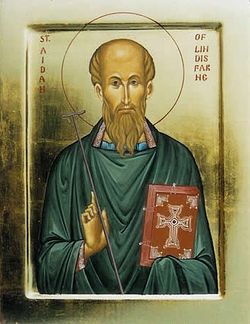 |
| St. Aidan. |
So there was an established British Church rather early, but when we talk about what it “was like,” we are talking about a church that was the same in fundamentals as the Gallic Church or the Spanish Church, the Italian Church, or the Church in Asia Minor… What was the difference between them? What was the difference, for example, between Irenaus of Lyons and anyone else in the Christian world? Obviously there were distinctive characteristics about Irenaean theology and his link with Asia Minor, but it was all part of the universal Church.
Another thing about the British Church that shows the extent to which things had developed, was the response to the Pelagian[1] heresy. Pelagius (the only British person to turn up in early patristic literature) spent much of his time in Rome, and in fact I think it’s Jerome that talks about him being “stuffed with Irish porridge,” which has misled some into thinking that he was Irish. Bishop Germanus of Auxerre in Burgundy (+448) was sent to Britain twice to help sort out the heresy. British representatives had participated in earlier councils, as well as in the reaction to the heresy, so Britain was obviously part of the main-stream Christian world.
RTE: You have said that Bede’s History of the English Church and People is so rich that it can be read over and over again, and is our basic text for the period. By Bede’s lifetime, were the original British inhabitants still there, had they been pushed out, or did they simply intermarry with the new Angle and Saxon settlers?
FR. JOHN: The Germanic peoples settled in Britain in the fourth, fifth and sixth centuries, from tribal groups that had settled along the coasts of Scandinavia, North Germany, and the Netherlands. They came first as mercenaries and economic migrants, but increasingly as adversaries and invaders. The Welsh, Scots and Irish called them Saxons or “Sassenachs”.
The rest of the world now knows their descendants as the English. Angles and Saxons formed the major groups and “Anglo-Saxon” is the term generally used to refer to them.
In the mid-nineteenth century there was a view, sparked by a quote of Gildas about the “ferocious Saxon,” of militarily superior Germanic peoples coming in and driving the local people (the British) west into Cornwall and Wales, leaving the Angles and Saxons (the “English”). There was bitter warfare between the Anglo-Saxons and the British, and many of the British who fled before the Northumbrian sword would have seen their churches taken over by the newly converted English. Even when both the British and the Anglo-Saxon (“English”) kingdoms were Christian, there are late seventh-, early eighth-century letters showing that they so distrusted each other that they wouldn’t eat off of the same plates.
There was also a general British move westwards to the mountain fastnesses to live separately, but the situation was more complex than this. There was probably a much stronger British presence left in Northumbria than is usually assumed, and Bede himself may be partly responsible for this under-representation of the British in the development of the Church. Although he consistently attacks them for failing to evangelize the English, there is every evidence to show that the Anglo-Saxon tribes were steadily being Christianized, but we don’t know by whom. All that Bede tells us about the Hwicce people of the Severn valley, for example, is that Wilfrid consecrated Oftfor as their bishop at Worcester. So, if they weren’t yet Christian, why did they need a bishop? This is one area where the silent evidence is very strong for a British Christian presence, strong enough to lead to the conversion of the incoming Angles.
Bede leaves us with the impression that the British were pretty much gone, and that the British churches had been taken over by the English Anglo-Saxons, as they were baptized. My guess is that there were British still around and that there had been a lot of intermingling. There is also some evidence that some of the British, including a bishop, were going to Galicia. This may have been on pilgrimage, but there were also people emigrating because of the Anglo-Saxon presence.
Formative Missions and Early Liturgies
RTE: So, in the sixth to seventh centuries in which Bede is writing, it seems we have a few very visible missionaries: St. Augustine of Canterbury sent by Pope Gregory the Great from Rome to southern Britain, and St. Paulinus who, as part of that same mission, baptized in Northumbia as well; St. Columba who left Ireland to found his monastery on Iona off the west coast of Scotland, and whose disciple, St. Aidan of Iona, in turn founded the great monastery at Lindisfarne on the east coast; and St. Wilfrid, who having received his monastic formation under Aidan, went to Rome and brought back more of the practices of the world-wide Church, founding influential monasteries in Northumbria and later becoming a bishop himself. 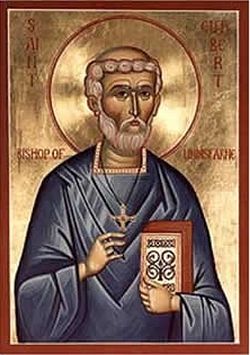 |
| St. Cuthbert |
There is really almost nothing in the first 700 years that we can point out now that is specifically Irish or British, other than individuals. If you pick any passage from one of Bede’s sermons, for example, without knowing who had written it, you could be reading any of the Greek or Latin fathers.
Another remarkable Northumbrian Angle was St. Benedict Biscop, who was a great traveler to the Mediterranean world, where he collected books, icons, and relics for his monasteries at Wearmouth and Jarrow, Bede’s own monastery. He persuaded both cantors and icon painters to come to Northumbria and teach his monks, and Biscop created one of the West’s great libraries at Jarrow, where Bede, among others, gained encyclopedic knowledge. St. Wilfrid not only went to Rome, but was also the first missionary to Frisia (northern Holland), and his disciple St. Willibrord came after him to establish Christianity there. A century later the well-known St. Boniface of Crediton was active in Germany. There would be a huge demand for manuscripts from Bede’s Jarrow monastery by the Germans, and Boniface himself wrote saying, “Please send these, I need them.” They used Bede’s History quite extensively, and there is speculation about what its importance would have been in the Christianization of the Germanic peoples. Some of these manuscripts still exist and seem to have been done in haste, with mistakes in spelling, etc.
RTE: It’s quite common for Orthodox to speak of missionaries having consistently translated the gospels and service books into local languages, but, that wasn’t the tradition in the West, was it? There wasn’t a written British, Welsh, Breton, or Irish ecclesiastical language. The liturgy and services would have all been in Latin.
FR. JOHN: Yes, always in Latin. The many small scraps of British liturgical manuscripts that we have from those early centuries are all in Latin, and probably all follow the Roman usage. They are very recognizable: “Let us lift up our hearts,” “And with thy spirit,” “Sanctus, sanctus, sanctus…” There is nothing here that is different or distinctive. They were part of the family of early western liturgies. The earliest fairly complete liturgical manuscript we have is from the eighth century.
In studying these fragments, liturgiologists may find small differences, but it is the same with our English Orthodox liturgies now. From place to place in the English-speaking world, we have small divergences of usage or expression, but there is nothing that shows a distinctive theology. We have no records of liturgical differences or of discussions about local usages, which indicates that, liturgically, everything was settled.
The earliest bit of non-Latin writing that we have is from the eighthcentury Lichfield Gospels. It is in Welsh. There is speculation that this manuscript originated in South Wales at Llandeilo Fawr, which means “the great holy place of St. Teilo,” and was probably a church. It is called Llantwit Major in English. St. Teilo had a big school there; he was contemporary with St. David of Wales, late fifth-early sixth centuries. The book is called the Lichfield Gospels because it is presently in Lichfield, England.
Seventh-Century Ireland
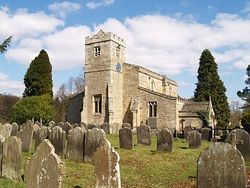 |
| The beautiful Lastingham Church which has 7th century Saxon and early Norman origins |
FR. JOHN: The Irish influence in seventh-century Northumbria was profound. The relations between Ireland and Britain go back to the earliest use of the seaways between Ulster and Argyll, between Wexford and southwest Wales, but this influence went both ways and we know that the early British (and this includes the area that is now Wales) were quite significant as missionaries, particularly along the coast of Ireland in the fourth and fifth centuries. We don’t have many details about their actual activity, but we do have names from the dedication of churches. The best-known British missionary is St. Patrick, the deacon’s son snatched by pirates from Britain and sold into slavery in fifth-century Ireland, who later returned as a free man intent on winning his pagan masters for Christ. The evidence of early churches named after certain saints links St. Patrick with Ulster and northeast Ireland. We also know of St. Patrick’s connection with Gaul, and interestingly, near St. Germanus’ relics in Auxerre, France, is an early fresco that the local people like to believe is Bishop Germanus blessing St. Patrick. In fact, there are some textual links between the two.
There were also Christians in the south of Ireland from early times. In 431 the Pope sent Bishop Palladius from Gaul to Ireland to organize an already existing church. Church dedications link this mission with Wicklow and with southwest Wales; it’s from Britain that the southern Irish had received their Christianity and learned their Latin.
Having received their faith from Britain, the Irish church became the most flourishing part of western Christendom in the sixth century. People came to Ireland from all over Europe to pray and study in the numerous monasteries, and Irish missionaries carried the faith across Europe, particularly to the Germanic kingdoms that had come into being after the collapse of Roman rule.
The great missionary movement from Ireland began in the sixth century.
The most famous examples of this are the two saints Columbanus and Columba, both named after the dove and noted for their ascetic life, but both men of authority and deep learning. Columbanus’ mission was to the Franks of Gaul and the Lombards of north Italy; Columba’s to the Picts.
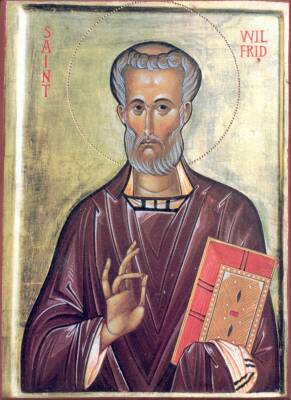 |
| St. Wilfrid |
Columba’s Iona became the centre of a major monastic commonwealth stretching from north Ireland, where daughter monasteries were founded at Derry, Durrow, Tiree in the Hebrides, Pictland and Northumbria. In 616, half a century after its foundation, the Northumbrian Prince Oswald came to live at Iona, and by Wilfrid’s time, there was no need to travel to Ireland, as Oswald had invited the Irish Aidan to Northumbria and it was at Aidan’s monastery at Lindisfarne that Wilfrid was first instructed in monasticism.
Besides the followers of Columba, such as Aidan and Cuthbert in Lindisfarne and Northumbria, there were already south Irish missionaries in Britain, such as St. Fursey in East Anglia, who were independent of Iona.
But, East Anglia was also influenced by clergy from Gaul, Northumbria, and Mercia and of course, the British, who are overlooked in all of the literature.
RTE: Authors who support the idea of very distinct differences between Celtic Christianity and that of the rest of England and the continent, often cite Egyptian and Coptic influences on art and monasticism in Christian Ireland. What do you think of this?
FR. JOHN: I think the evidence for artistic influence from the eastern Mediterranean is clear, and to be expected from the importance of the searoutes we discussed earlier on. The swirls on the cover of St. Cuthbert’s pocket Gospel book, buried with him in his coffin, are often linked with Coptic design. Monasticism had its origins in the wilderness of Palestine and the deserts of Egypt, and spread out from there. The influence of St. Athanasius’ life of St. Antony in its Latin translation was crucial in the spread of the monastic ideal to the West. Doubtless there were direct connections between the monastics of the East and the Irish, as there were with southern Gaul, for example. This is rather a point of similarity between Irish traditions and those of the Continent, than of distinctiveness.
RTE: In your book on St. Wilfrid, you mention several very influential Northumbrian women. Did the role of women in Northumbria and Ireland differ from the rest of the Church?
FR. JOHN: Women were of the utmost importance in the Church of seventhcentury Britain. I tried to bring this out in the book on St. Wilfrid. Queen Eanfled was very much St. Wilfrid’s spiritual mother in his formative years, and continued to influence him throughout her life. Queen Bertha probably did as much to bring the Gospel to the Germanic people of Kent as did Augustine. The role of these powerful queens in the policy of the newlyformed Anglo-Saxon kingdoms was substantial. Better known, of course, is St. Hilda, whose monastery at Whitby was a training ground for future clergy, including bishops; she was very much a teacher of the teachers. There are other examples of such ‘double’ monasteries, that is both a monastery for women and one for men, under the joint direction of an abbess. And it was always an abbess, not an abbot. These occurred in the Frankish areas of the continent. Other examples of such important women leaders were St. Mildred on the isle of Thanet in Kent, and St. Milburgha in Shropshire. This leadership role of women seems to have been a particular feature of the Anglo-Saxon and other Germanic Christians. They also played an important part in the Anglo-Saxon missions to Germany.
RTE: What can we say about the early Church in the area that is now Wales?
FR. JOHN: We know of St. Samson, St. Beuno, St. David, St. Illtyd and St. Petroc, and others who were active in Wales, Cornwall and Brittany (northern France) in the sixth to seventh centuries. When the Anglo-Saxon pagans arrived in Britain, they found a well-established British church with its bishops, martyrs, monastics, missionaries, its hermitages, monasteries, parish churches, liturgical traditions, relics and iconography.
This we discussed earlier. Increasingly, the centre of gravity of the ancient British church shifted towards the West. There was little Anglo-Saxon influence on Wales and Cornwall. But, as I said before, the British presence in ‘England’ continued.
Orthodox Rome
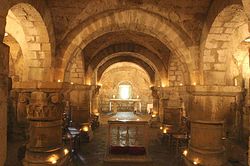 |
| Lastingham Crypt |
FR. JOHN: …as Rome always had to. Most of the heresies were eastern inventions, weren’t they? Rome might not have been as inventive as eastern Christendom, but it held a clear Orthodox traditional position.
Going back for a moment to the previous century, St. Augustine of Canterbury had come in 597, sent by St. Gregory the Great (+603). Gregory was an important and major figure, who reformed the whole of northern Italy after the Lombard invasions. Virtually all of Europe was under Germanic influence: the Lombards in north Italy, the Anglo-Saxons and Jutes in Britain, the Franks in France, and the Visigoths in Spain. Following the Lombard invasions came famine and plague; everything fell apart. It was St. Gregory, as pope of Rome and of patrician background, who was able to bring about the revival of Italy – through the movement of grain, the feeding of the people, the rebuilding of cities and churches. He not only gave all of his family wealth for this physical revival, but he took a very active interest in the liturgical and monastic life of Rome and the development of the Church’s mission.
The Persian invasions of the Holy Land (they took Jerusalem in 614) led to a large number of Syrian, Palestinian and Greek exiles seeking refuge in Rome, where they established monasteries and other institutions. Rome became a place of great ethnic and linguistic diversity, with a variety of liturgical and ecclesiastical traditions.
Also, 621 marked the flight of Mohammed from Mecca to Medina, which was the beginning of Muslim influence. Within a decade of his death, Muslims had moved through the Middle East and North Africa. This is when many Christians, including Theodore of Tarsus, the Syrian monk whom the pope named the first archbishop of Canterbury, fled to Italy. In 641 a Greek from Jerusalem became pope, and many of the popes of the following century were also Greek or Syrian. There were quite important Greek and Syrian monasteries in Rome at this time, and Greek elements were introduced into the Roman liturgy.
There were also theological exiles in Rome from the East. In his attempts to reconcile the Monophysite Christians of Egypt and gain their support in his conflicts with the Persians and Arabs, Emperor Heraclius involved himself in theology by attempting to impose an unorthodox, compromise doctrine known as Monothelitism[2] on the Church. He persecuted the doctrine’s opponents, such as the great theologian of the seventh century, Maximus the Confessor, and many of them also made their way to Rome. The Lateran Council of 649 in Rome dealt with the question of Monothelitism, which was condemned in 681 in Constantinople by the Sixth Ecumenical Council.
Many of the seventh-century popes used their position to create impressive churches, such as St. Pancras. St. Peter’s was refurbished and great secular buildings like the Senate house were converted into churches. Much of the architecture and iconography of these new buildings was the work of Byzantine artists, and the city took on an appearance not unlike Ravenna and Constantinople.
When Wilfrid went to Rome in 702-3 to plead his case over his uncanonical deposition, he appeared in front of Pope John, a Greek. The Greek fathers of the council discussed the charges in Greek, in proceedings lasting over seventy sessions and four months. His appeal to Rome was fitting.
If Wilfrid had been in Asia Minor, he would have appealed to Constantinople; a bishop in his position in Syria would have appealed to Antioch. Protestant historians who posit an early British church independent of Rome and castigate Wilfrid for seeking to bring Britain into subservience to the pope are as far from the mark as those Roman Catholics who use Wilfrid’s appeal to Rome as evidence for a full-blown doctrine of papal primacy in the seventh century.
There was a unity of practice and understanding in the seventh century that’s difficult for us to appreciate now. It was possible for someone holding the office of bishop to be an Irishman in Gaul, a Syrian in Rome, or a Greek in Britain. For instance, Bishop Agilbert, a Frank who became a bishop in Gaul, then went to Ireland to study the Scriptures. From Ireland he went to England as bishop to the kingdom of the West Saxons, and later returned to Gaul to accept the bishopric of Paris, which he held from 664 until his death. His life is an example of the rich diversity of Christian influence on Britain – Irish, Gallic, Frankish, and Roman.
Agilbert was also the bishop who ordained Wilfrid to the priesthood in his own monastery at Ripon and brought him to the fore at the meeting often called the Synod of Whitby in 664.
The Synod of Whitby
 |
| Escomb Church |
FR. JOHN: They were two of the three things that Augustine of Canterbury had brought up at his meeting with the British bishops: the dating of Easter and the form of the monastic tonsure – that is, the way in which monks cut their hair after taking their vows. The completion of baptism by the bishop, probably meaning chrismation, was the third thing, but that was not raised at Whitby. The dating of Easter was by far the most serious issue.
In regards to chrismation, what is fairly clear from the texts we do have from the West, and in the Byzantine rite for baptism, is that virtually all of the churches allowed the priest to administer chrismation, in fact they expected it to be so. But Rome was distinct in saying that the sacrament should be given by the bishop.
RTE: As it remains today. A Catholic bishop administers confirmation parish by parish, to groups of young people around age 12-14.
FR. JOHN: Yes. The Anglicans follow this as well, and it’s quite easy to see how this came about. No bishop could attend every baptism, so they had to split the sacrament and put the chrismation off until he came around. Over the centuries, it was pushed further and further back.
That was the third point and interestingly, at the Synod of Whitby where the first two practices were decided, this third question was not even mentioned. Yet, we find Cuthbert, who is often claimed as an honorary Celt, going around and completing baptisms following the Roman practice. Ireland itself didn’t change to the Roman confirmation practice until the eleventh or twelfth centuries. This is another instance where the divisions between the “Celtic” and “Roman” contingents were not so clear-cut.
The main purpose of the Synod of Whitby was to resolve the question of the date of Easter. It was important that the unity of the Church should be particularly clear on the most important festival of the year. As it was, those who followed the “Irish” calendar – and they included King Oswy of Northumbria and the monastics of Lindisfarne and Whitby, whom his father King Oswald had brought from Iona – could be celebrating the Resurrection, while those who followed the “Roman” date, including Oswy’s queen, Eanfled, were still keeping the Lenten fast. This was bad for the unity of the Church, but it also caused political disunity in Northumbria.
Oswy summoned both political and religious leaders to the Synod, as Constantine and other Christian rulers had before him.
Bede gives us a rather full account of the proceedings, with St. Wilfrid acting as spokesman for the universal “Roman” date kept by the Church throughout the world, and St. Colman, Bishop of Northumbria, for the “Irish” date, which traditionally had the authority of the Apostle and Evangelist John, and was used by the northern Irish, St. Columba, and the Iona monastics. (Although, even within the “Irish” usage, there were a variety of observances.) Interestingly, this was not the practice of all of the Irish. The southern Irish had already changed to the universal Church dating of Easter. St. Wilfrid did not deny the sanctity of Columba, nor did he think that the Ionan way of keeping Easter was seriously harmful if they were unaware of the rest of the Church’s unanimity in observing the universal date. Once they were aware, however, that they alone were keeping another date, they should acquiesce.
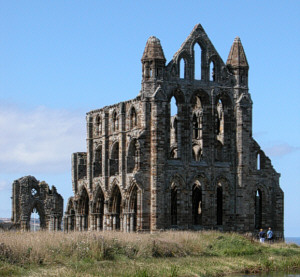 |
| Whitby Abbey |
It wasn’t an issue after that. Even the northern Irish, to whom Colman and his monks went after leaving Northumbria, voluntarily changed their practice within fifty years. Iona itself adopted the universal dating of Easter in 716 and Whitby was only resurrected as an issue by Protestant reformers at the time of the Reformation.
It’s extraordinary how people now get so worked up about the Synod of Whitby. It would be understandable if it were about something fundamental, like the sermons that have gone on in Durham in recent years, with an Anglican bishop speaking of the Resurrection as “a conjuring trick with bones.” This is an important divergence from the fundamentals of the Faith, but how a monk cuts his hair is not.
RTE: Orthodox Christians who see the Council of Whitby as an Armageddon that stifled a great spiritual tradition often don’t know that after the Russian Revolution in 1917, one of the conditions set by the newly independent state of Finland to recognize Orthodoxy as one of its national churches, was that the Finnish Orthodox would exclusively use the Gregorian calendar.
FR. JOHN: Which is a radical change because the Gregorian calendar is now in conflict with Nicea, although that wasn’t done deliberately. Still, once or twice a decade, Pascha celebrated according to the Gregorian calendar falls either on or before the Jewish Passover, not after, as the Nicean Council decreed it must. Pascha must follow the Old Passover. It cannot coincide or precede it. Moving Pascha to the Gregorian calendar was a fundamental change, it broke the ancient practice of the Church, whereas Whitby brought all into unity.
The Idea of a Celtic Church
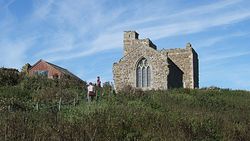 |
| Church on Farne on the site of St Cuthbert's cell |
FR. JOHN: I think there is a lot in that, and if you read the Frenchman Ernest Renan and the Englishman Matthew Arnold, they make a radical distinction between the Celts and the Anglo-Saxons – the Celt being nature-loving, mystical, spiritual and the Anglo-Saxon being organized, efficient and technocratic.
They even talk about industrialization, but from the standpoint of their own nineteenth-century anti-industrialization movement, which they project back onto these two peoples. What’s even more bizarre, of course, is that St. Cuthbert is always presented as a great representative of the Celtic tradition, but in fact, he was an Englishman, an Anglo-Saxon...
RTE: …who was quite in agreement with the Synod of Whitby.
FR. JOHN: Yes. And Aidan, on the other hand, who was one of the “real Celts” from Iona, was running around the peninsula organizing: converting kings, baptizing people, setting up churches, like any good “Anglo-Saxon.”
If you adhere to this notion of “Anglo-Saxon” versus “Celtic” Christianity, then you also have to decide what to think about Irish and British Christianity. Are they, or are they not the same thing? There was a definite relationship between Britain and Ireland but the Irish practices weren’t always the same as the British, but they were both Celts.... So what is this “Celtic Christianity?” It’s a confusing and not very helpful term. Neither the Irish/Scotti, nor the British/Welsh/Bretons would have ever thought of themselves as belonging to a “Celtic church” that was somehow separate from the rest of the Church.
So this is partly unclear thinking, and partly a creation of Anglican reformers in the sixteenth century who had to demonstrate a pre-Roman Church in Britain of which they were the continuation, in order to show that the medieval Catholic period had been a disruption of that. So Wilfrid, who was the spokesman for the Orthodox Easter at Whitby, was seen as “Roman” and demonized. The Celtic overlay came later.
RTE: A strong affinity with nature, and a less austere, more “warm-hearted” approach often glosses our modern view of the Celtic-speaking monks, but when one reads the early penitentials and monastic rules, there was also a rigorous asceticism – monks standing in prayer through the night up to their necks in ice-cold water, arduous fasting and strict penance for sin.
And, their prayers and poetry often seem to be a request for protection against the forces of nature. It wasn’t an endless summer.
FR. JOHN: Yes. Some of the earliest poetry we have is British, from the eighth, ninth, tenth centuries, although it could be based on something earlier.
In this, there is a strong emphasis on nature, on the Incarnation and the Resurrection, all of which makes them particularly close to the Fathers of the East. But, there is nothing in the documents up to the time of Bede that tells us much about them. As you say, we have these monastic rules which are very austere, and say traditional sorts of things about humility and so on, just as you would find in the sayings of the Egyptian desert fathers. Also, you had the centrality of the office, and above all, the psalms.
In many monasteries and hermitages the entire psalter was said twice a day, often from memory.
All of these things differ from this modern view that they were rather relaxed about rules. Nor, of course, was St. Cuthbert, who is often held up as a prototype Celtic monk. In Bede’s life of Cuthbert, Bede describes his very firm treatment of the monks when he becomes abbot of Lindisfarne.
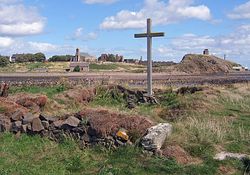 |
| Cross and chapel on St Cuthbert's Isle looking towards Holy Island |
It’s a little upsetting to find our own Orthodox people taking these passionate and one-sided views. It doesn’t really matter if a saint is Celtic, British, Anglo-Saxon, Roman, Greek or Syrian, if there is something in his life we can learn from. There’s a new book out, The Lost Saints of Britain by Ian Thompson, about the “Celtic” saints who have been lost because of the nasty Anglo-Saxons and a horrible Greek named Theodore who tried to destroy the Celtic tradition!
And why was it so important in this new book to vilify St. Wilfrid, for example, to the extent of putting a special appendix, a psychoanalysis saying he suffered from sexual repression as evidenced by his cold baths? Even if it were true, does this mean that everyone who takes a cold bath is repressed? The greatest cold bather was Cuthbert, standing up to his neck in freezing water. So did many of the Irish ascetics and one of the Jarrow monks who stood in the Tyne with ice floating around him.
RTE: Could you say a bit more about this horrible Greek? We often miss the point that possibly the greatest archbishop of Canterbury was neither British nor Roman, but a Syriac-speaking monk from Antioch – a highly educated and saintly eastern Church Father.
FR. JOHN: Theodore was born in Tarsus, educated in Antioch, probably studied in Constantinople and later emigrated to Rome after the Persian invasions. He was sixty-six or sixty-seven when he was sent by the pope to be the archbishop of Britain, and he died twenty-one years later. He was the expert in the west on Monothelitism.
The Lateran Council that dealt with the Monothelite heresy, had been called in 649, and the Pope assembled evidence from all over the western world. He asked Theodore to draw up a statement of faith for the council. He set up a famous school in Canterbury that Bede is very complimentary about, where he taught Greek and Latin.
We have fragments of some of his learned biblical commentaries and analysis. We are sure they are his because they were written by someone writing in Latin as a second language, who knew Syriac and the eastern Christian world. His geographical and horticultural notes about the Near East are unmistakable.
He had great authority with the Anglo-Saxon kings, and he created a diocesan structure here, to properly attend to people’s spiritual needs. In his twenty- one years as archbishop, he created a diocesan structure so well-tuned to the diverse cultural and geographical realities of the country that many of the dioceses he created remain in place to this day. He was the first primate of England to hold councils of the whole church to establish an ordered and common pattern of life in all the disparate kingdoms of the land.
RTE: And taking into account what Gildas, and later Bede in his letter to the bishop, said about the state of the Church, perhaps this was necessary.
FR. JOHN: Yes. Of course, you can also find evidence for some for the things people sometimes criticize, because Archbishop Theodore was trying to bring about a uniform ecclesiastical practice among these small kingdoms and diverse peoples, and there were quite strong rules and canons.
RTE: Going back to claims for a distinctly separate Celtic church, I remember Dr. Tarek Mitri, an Orthodox professor from Lebanon, saying that while we seem to be growing more alike in our tastes and preferences on a global level, we are actually breaking down into smaller and smaller groups as a way to locate ourselves, and this often results in a search for ambiguous “roots” or identities. For instance, now in the Balkans, there are ethnic groups which are trying to reconstruct their histories to reflect what they would like to believe about themselves.
FR. JOHN: And, of course, the internet makes it possible to create a substantial community of one or two thousand people without actually meeting them. Some people inhabit that world.
RTE: Also, after Protestant reformers minimized prayer to the Mother of God and the saints and prohibited the veneration of relics and prayers for the dead, it is understandable that some contemporary Protestants feel the need to compensate for this lost spiritual contact by emphasizing the “warm-hearted” and “green” aspects of early British and Irish Christianity.
We often don’t realize that early texts such as Bede’s History of the English Church and People, or the Life of St. Columba by Adamnan, are richer and more satisfying than what has been written about as “Celtic” in the past fifty years. Going back to these contemporary writings is a tonic, like refreshing oneself with the Gospel after a spell of cloudy theology.
FR. JOHN: I think you have touched on another very important source for these romantic views of the ‘Celtic church.’
RTE: Yet it is difficult to completely renounce this sense of “differentness” that many of us have felt in what we’ve thought of as the Celtic church.
Although the romantic view has been overstated, can you sum up the truly distinctive characteristics of Christianity in Celticspeaking lands?
FR. JOHN: I think most of them have arisen in our discussions: a love of the monastic life with all its rigours, its discipline, and its harmony with the created world; the centrality of a life of prayer, based on the psalms; a commitment to the spreading of the faith; an emphasis on the Incarnation and the Resurrection of our Lord; a devotion to learning; and a creative and open artistic imagination that was able to develop a rich harmony of its own traditions with those of the wider Christian world.
But I think that if one dips into those great illuminated manuscripts, they show the unity and harmony of the northern Christian world in Bede’s time. For instance, some of the wellknown “Celtic” pages in the Lindisfarne Gospel are not Irish, but Anglo- Saxon, and the monks producing these illuminated manuscripts in monastery workshops would have known and included earlier Christian styles, such as in the Roman mosaics along Hadrian’s Wall.
There was also a strong seventh-century Mediterranean influence on the texts that I mentioned earlier; some of this influence was from Rome and Gaul, and some from Middle Eastern and North African exiles who had gathered in Rome. Also, you’ve got the strange depictions of animals, elongated dogs and other creatures that are quite distinctly Germanic, and the threelegged, so-called, triskeles that are Irish. There was mutual influence here. There is uncertainty about where many of these manuscripts actually originated.
The Book of Kells could have come from a Northumbrian workshop via Iona. It contains an icon of the Mother of God that is pure Byzantine. So, in all these illuminated manuscripts you have the Romano-Greek Mediterranean influence, the Germanic influence, and the Irish influence, all beautifully synthesized. That is the reality and the beauty of the Church in this country – it had all of these elements.
30 / 03 / 2009
[1]Pelagianism: A heresy constructed by Pelagius, a fifth -century British lay ascetic, and Celestius, a priest, who denied the inheritance of the sin of Adam by his descendants, considering that each man is born innocent, and only thanks to moral freedom does he fall into sin. Pelagianism was condemned at the Third Ecumenical Council, along with Nestorianism.
[2] Monothelitism: Monothelitism was a softened form of Monophysitism. While acknowledging two natures in Christ, the Monothelites taught that in Christ there was only one will – namely the Divine will. Adherents of the doctrine included several patriarchs of Constantinople who were later excommunicated (Pyrrhus, Paul, Theodore) and Honorius, Pope of Rome. The teaching was rejected as false at the Sixth Ecumenical Council
Subscribe to:
Posts (Atom)
